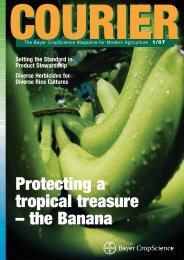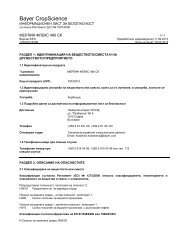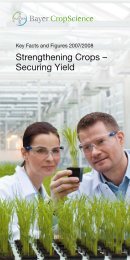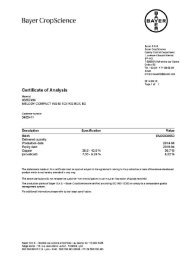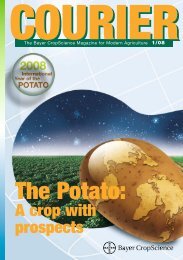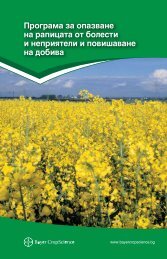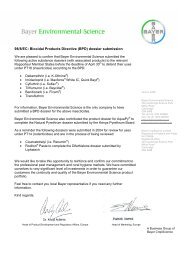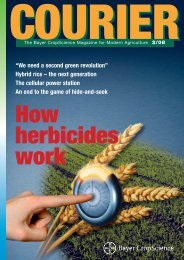For healthy potatoes - Bayer CropScience
For healthy potatoes - Bayer CropScience
For healthy potatoes - Bayer CropScience
Create successful ePaper yourself
Turn your PDF publications into a flip-book with our unique Google optimized e-Paper software.
A soil structure with the optimum self-regulatory mechanisms is the basis for<br />
sustainable agriculture.<br />
Precision farming is a technology with strong potential in the service of agriculture<br />
and the management of natural resources.<br />
management of natural resources is inextricably<br />
linked to improving the productivity<br />
and profitability of farmers worldwide;<br />
the challenge is to reach out to them.<br />
Better information and<br />
precision farming technologies<br />
One of the most exciting areas of innovation<br />
lies in the development and application<br />
of information and precision farming<br />
tools for agriculture and natural<br />
resources management. Precision farming<br />
(PF), or Site Specific Crop Management<br />
(SSCM), is defined as “a systems’<br />
approach to managing soils and crops to<br />
reduce decision uncertainty through better<br />
understanding and management of spatial<br />
and temporal variability”. Expertise from<br />
many disciplines is utilised to integrate<br />
data from multiple sources to support decision-making<br />
at field, farm, watershed<br />
and/or regional levels. Most applications to<br />
date have focused on optimising the use of<br />
nutrients, pesticides, water and energy.<br />
It is clear that PF technology needs to<br />
be used in ways that fit local farming conditions<br />
but there is no doubt that site-specific<br />
management can improve profitability.<br />
Adoption of PF in different parts of the<br />
world has progressed patchily. In Europe<br />
and North America, efforts to reverse the<br />
long-term decline in profitability coupled<br />
with environmental issues of agriculture<br />
have been the main drivers. In some developing<br />
countries, simplified forms of<br />
SSCM have been created, driven by the<br />
need to produce more food, utilise inputs<br />
more efficiently and increase farm profits<br />
in response to declining food prices. The<br />
various concepts and technologies that will<br />
constitute tomorrow’s precision agriculture<br />
are still emerging.<br />
Where next<br />
The above examples by no means exhaust<br />
the range of innovative technologies and<br />
approaches that are becoming increasingly<br />
available to tackle the on-going challenge<br />
of sustainable increased productivity facing<br />
world agriculture. In the quest for the<br />
best solutions, trade-offs have been done in<br />
the past at the expense of the environment.<br />
But this is no longer acceptable and lessons<br />
have been learnt that are leading to a<br />
more integrated and holistic farming<br />
approach. Balanced resource management<br />
is key and <strong>Bayer</strong> <strong>CropScience</strong> is confident<br />
that its scientists will make an increasing<br />
contribution over the years ahead. The<br />
company in this context is committed to<br />
promoting the adoption of more sustainable<br />
land management practices at a landscape<br />
level within the framework of ecoagriculture<br />
through ICM. Building the<br />
capacity to develop innovative locallyadapted<br />
approaches, especially for the<br />
many small scale farmers hungry for<br />
knowledge will need to be addressed most<br />
effectively through cooperation with governments,<br />
non-governmental organisations,<br />
international organizations and<br />
development agencies, the agri-food<br />
industry and farmer’ organisations.<br />
<strong>Bayer</strong> <strong>CropScience</strong> operates within a<br />
multitude of economic, social, political<br />
and environmental contexts at the local,<br />
national or regional levels that are constantly<br />
changing and evolving. Doing business<br />
varies accordingly and the challenge<br />
is to tailor activities that benefit the environment,<br />
social equity and <strong>healthy</strong> economic<br />
growth in the communities in question.<br />
We need to have a good idea of future<br />
needs to guide research starting now as<br />
new products commonly take over a<br />
decade to develop before they reach users.<br />
The pace of change is accelerating and<br />
hence calls for a matching response from a<br />
R&D company. <strong>Bayer</strong> <strong>CropScience</strong> stands<br />
ready to share views with key stakeholders<br />
to see how best choices can be made<br />
together to achieve our common goal: sustainable<br />
development in agriculture. ■<br />
Annik Dollacker,<br />
<strong>Bayer</strong> <strong>CropScience</strong> AG, Germany<br />
2/06 COURIER 27





